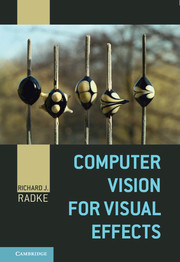Book contents
7 - Motion Capture
Published online by Cambridge University Press: 05 December 2012
Summary
Motion capture (often abbreviated as mocap) is probably the application of computer vision to visual effects most familiar to the average filmgoer. As illustrated in Figure 7.1, motion capture uses several synchronized cameras to track the motion of special markers carefully placed on the body of a performer. The images of each marker are triangulated and processed to obtain a time series of 3D positions. These positions are used to infer the time-varying positions and angles of the joints of an underlying skeleton, which can ultimately help animate a digital character that has the same mannerisms as the performer. While the Gollum character from the Lord of the Rings trilogy launched motion capture into the public consciousness, the technology already had many years of use in the visual effects industry (e.g., to animate synthetic passengers in wide shots for Titanic). Today, motion capture is almost taken for granted as a tool to help map an actor's performance onto a digital character, and has achieved great success in recent films like Avatar.
In addition to creating computer-generated characters for feature films, motion capture is pervasive in the video game industry, especially for sports and action games. The distinctive mannerisms of golf and football players, martial artists, and soldiers are recorded by video game developers and strung together in real time by game engines to create dynamic, reactive character animations. In non-entertainment contexts, motion capture is used in orthopedics applications to analyze a patient's joint motion over the course of treatment, and in sports medicine applications to improve an athlete's performance.
- Type
- Chapter
- Information
- Computer Vision for Visual Effects , pp. 255 - 299Publisher: Cambridge University PressPrint publication year: 2012



